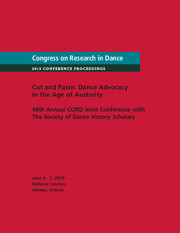No CrossRef data available.
Article contents
The “Effeminate Dancer” in Greco-Roman Egypt: The Intimate Performance of Ambiguity
Published online by Cambridge University Press: 04 January 2013
Abstract
In the cosmopolitan Greco-Roman world of the second and third centuries CE, the terms magodos, malakos, and kinaidos/cinaedus identified a category of performer usually described (inadequately) as the “effeminate dancer.” This paper investigates the nature of the “effeminate dancer's” performance and his function in the various societies in which such entertainment is attested, focusing on Roman Egypt. In a world where men typically played women's roles in mainstream drama and dance, the “effeminate dancer's” performance eluded these accepted conventions of theatrical illusion. Raising the specter of distorted masculinities such as the passive homosexual and the eunuch, and evoking the ecstatic cults that were a mainstay of feminine religious experience in the ancient Mediterranean, the “Effeminate dancer” stirred up anxieties about social and sexual transgression and simultaneously allayed them through elegant performance.
- Type
- Research Article
- Information
- Copyright
- Copyright © The Author(s) 2008


